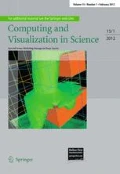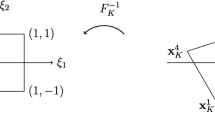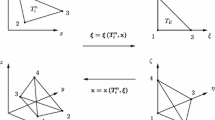Abstract
In this paper we present an algorithm to refine space–time finite element meshes as needed for the numerical solution of parabolic initial boundary value problems. The approach is based on a decomposition of the space–time cylinder into finite elements, which also allows a rather general and flexible discretization in time. This also includes adaptive finite element meshes which move in time. For the handling of three-dimensional spatial domains, and therefore of a four-dimensional space–time cylinder, we describe a refinement strategy to decompose pentatopes into smaller ones. For the discretization of the initial boundary value problem we use an interior penalty Galerkin approach in space, and an upwind technique in time. A numerical example for the transient heat equation confirms the order of convergence as expected from the theory. First numerical results for the transient Navier–Stokes equations and for an adaptive mesh moving in time underline the applicability and flexibility of the presented approach.
Similar content being viewed by others
References
Abedi, R., Chung, S.-H., Erickson, J., Fan, Y., Garland, M., Guoy, D., Haber, R., Sullivan, J.M., Thite, S., Zhou, Y.: Spacetime meshing with adaptive refinement and coarsening. In: Proceedings of Symposium on Computational Geometry, pp. 300–309 (2004)
Arnold D.N, Brezzi F., Cockburn B., Marini D.: Unified analysis of discontinuous Galerkin methods for elliptic problems. SIAM J. Numer. Anal. 39, 1749–1779 (2002)
Baumann C.E., Oden J.T.: A discontinuous hp finite element method for convection–diffusion problems. Comput. Methods Appl. Mech. Eng. 175, 311–341 (1999)
Baumgartner L.: Zerlegung des n-dimensionalen Raumes in kongruente Simplexe. Math. Nachr. 48, 213–224 (1971)
Behr M.: Simplex space–time meshes in finite element simulations. Int. J. Numer. Methods Fluids 57, 1421–1434 (2008)
Bey J.: Simplicial grid refinement on Freudenthal’s algorithm and the optimal number of congruence classes. Numer. Math. 85, 1–29 (2000)
Chen Z., Steeb H., Diebels S.: A space–time discontinuous Galerkin method applied to single-phase flow in porous media. Comput. Geosci. 12, 525–539 (2008)
Cockburn B., Gopalakrishnan J., Lazarov R.: Unified hybridization of discontinuous Galerkin, mixed, and continuous Galerkin methods for second order elliptic problems. SIAM J. Numer. Anal. 47, 1319–1365 (2009)
Coxeter H.S.M.: Regular Polytopes. Dover, New York (1973)
Egger H., Schöberl J.: A hybrid mixed discontinuous Galerkin finite-element method for convection–diffusion problems. IMA J. Numer. Anal. 30, 1206–1234 (2010)
Freudenthal H.: Simplizialzerlegungen von beschränkter Flachheit. Ann. Math. 43, 580–582 (1942)
Gonçalves E.N., Palhares R.M., Takahashi R.H.C., Mesquita R.C.: Algorithm 860: simpleS—an extension of Freudenthal’s simplex subdivision. ACM Trans. Math. Softw. 32, 609–621 (2006)
Haiman M.: A simple and relatively efficient triangulation of the n-cube. Discret. Comput. Geom. 6, 287–289 (1991)
Johnson C.R., Hansen C.: The Visualization Handbook. Elsevier–Butterworth Heinemann, Oxford (2005)
Masud A., Hughes T.J.R.: A space–time Galerkin/least-squares finite element formulation of the Navier–Stokes equations for moving domain problems. Comput. Methods Appl. Mech. Eng. 146, 91–126 (1997)
Neumüller, M.: Eine Finite Element Methode für optimale Kontrollprobleme mit parabolischen Randwertaufgaben. Masterarbeit, Institut für Numerische Mathematik, Technische Universität Graz (2010)
Orden D.: Asymptotically efficient triangulations of the d-cube. Discret. Comput. Geom. 30, 509–528 (2003)
Rivière B.: Discontinuous Galerkin Methods for Solving Elliptic and Parabolic Equations. SIAM, Philadelphia (2008)
Sudirham J.J., van der Vegt J.J.W., van Damme R.M.J.: Space–time discontinuous Galerkin method for advection–diffusion problems on time-dependent domains. Appl. Numer. Math. 56, 1491–1518 (2006)
Tezduyar T.E.: Interface-tracking and interface-capturing techniques for finite element computation of moving boundaries and interfaces. Comput. Methods Appl. Mech. Eng. 195, 2983–3000 (2006)
Tezduyar T.E., Behr M., Liou J.: A new strategy for finite element computations involving moving boundaries and interfaces—the deforming-spatial-domain/space–time procedure. I. The concept and the preliminary numerical tests. Comput. Methods Appl. Mech. Eng. 94, 339–351 (1992)
Tezduyar T.E., Behr M., Mittal S., Liou J.: A new strategy for finite element computations involving moving boundaries and interfaces—the deforming-spatial-domain/space–time procedure. II. Computation of free-surface flows, two-liquid flows, and flows with drifting cylinders. Comput. Methods Appl. Mech. Eng. 94, 353–371 (1992)
Tezduyar T.E., Sathe S.: Enhanced-discretization space–time technique (EDSTT). Comput. Methods Appl. Mech. Eng. 193, 1385–1401 (2004)
Thomee V.: Galerkin Finite Element Methods for Parabolic Problems. Springer, Berlin (1997)
van der Vegt J.J.W., Sudirham J.J.: A space–time discontinuous Galerkin method for the time-dependent Oseen equations. Appl. Numer. Math. 58, 1892–1917 (2008)
Author information
Authors and Affiliations
Corresponding author
Rights and permissions
About this article
Cite this article
Neumüller, M., Steinbach, O. Refinement of flexible space–time finite element meshes and discontinuous Galerkin methods. Comput. Visual Sci. 14, 189–205 (2011). https://doi.org/10.1007/s00791-012-0174-z
Received:
Accepted:
Published:
Issue Date:
DOI: https://doi.org/10.1007/s00791-012-0174-z




